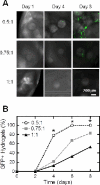Spontaneous cardiomyocyte differentiation of mouse embryoid bodies regulated by hydrogel crosslink density
- PMID: 24748962
- PMCID: PMC3987919
- DOI: 10.1039/C3BM60139K
Spontaneous cardiomyocyte differentiation of mouse embryoid bodies regulated by hydrogel crosslink density
Abstract
Cellular therapies have great potential to provide alternative treatment options for those suffering from heart disease. In order to optimize cell delivery for therapeutic efficacy, a greater understanding of parameters that impact stem cell differentiation, survival, growth, and development are needed. In this study, we examine the role of hydrogel crosslink density on spontaneous cardiomyocyte (CM) differentiation of murine embryoid bodies (EBs). CM differentiation was accelerated in hydrogels of low crosslink density, where 100% of the hydrogels were positive for CM differentiation compared to only 53% in the high crosslink density group after 8 days of culture. DNA microarray data suggests that enhanced CM differentiation in the low crosslink density hydrogels was not tissue specific but rather a result of favoured EB development and cell proliferation. Additionally, enhanced EB growth and differentiation in low crosslink density hydrogels was independent of RGD ligand density and not a consequence of enhanced diffusion. We also demonstrate that matrix metalloproteinase activity is required for spontaneous CM differentiation in 3D hydrogels. Low hydrogel crosslink density regulates spontaneous EB differentiation by promoting EB growth and development. Elucidating the effects of microenvironmental cues on cell differentiation can aid in the optimization of stem cell-based therapies for tissue regeneration.
Figures







References
-
- Lloyd-Jones D, Adams RJ, Brown TM, Carnethon M, Dai S, De Simone G, Ferguson TB, Ford E, Furie K, Gillespie C, Go A, Greenlund K, Haase N, Hailpern S, Ho PM, Howard V, Kissela B, Kittner S, Lackland D, Lisabeth L, Marelli A, McDermott MM, Meigs J, Mozaffarian D, Mussolino M, Nichol G, Roger VL, Rosamond W, Sacco R, Sorlie P, Thom T, Wasserthiel-Smoller S, Wong ND, Wylie-Rosett J. Circulation. 2010;121:e46–e215. - PubMed
-
- Langer R, Vacanti JP. Science. 1993;260:920–926. - PubMed
-
- Kong HJ, Smith MK, Mooney DJ. Biomaterials. 2003;24:4023–4029. - PubMed
-
- Laflamme MA, Chen KY, Naumova AV, Muskheli V, Fugate JA, Dupras SK, Reinecke H, Xu C, Hassanipour M, Police S, O'Sullivan C, Collins L, Chen Y, Minami E, Gill EA, Ueno S, Yuan C, Gold J, Murry CE. Nat Biotechnol. 2007;25:1015–1024. - PubMed
Grants and funding
LinkOut - more resources
Full Text Sources
Other Literature Sources

